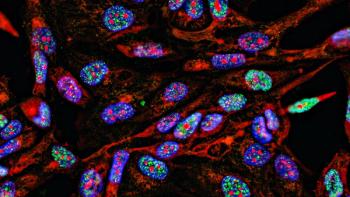
- Pharmaceutical Technology-09-02-2015
- Volume 39
- Issue 9
A Matter of Taste
Matt Shaffer, manager, formulation development, Bend Research, a division of Capsugel’s Dosage Form Solutions business, and Martin Koeberle, PhD, head of analytical development and stability testing, Hermes Pharma, spoke to Pharmaceutical Technology about the different approaches used in taste-masking and the challenges involved.
The taste of an oral dosage form has significant impact on patient compliance. As a result, there is increasing interest in taste masking as the pharmaceutical industry invests more resources into the development of palatable and pleasant tasting formulations. Matt Shaffer, manager, formulation development, Bend Research, a division of Capsugel’s Dosage Form Solutions business, and Martin Koeberle, PhD, head of analytical development and stability testing, Hermes Pharma, spoke to Pharmaceutical Technology about the different approaches used in taste masking and the challenges involved.
PharmTech: Can you discuss the challenges in taste masking, particularly when developing formulations for the pediatric and geriatric populations?
Shaffer (Capsugel): The overall challenge stems from trying to meet diverse product attributes in a narrow formulation space. Palatability is a subjective metric that has shown significant dependence on more than just patient age, making it difficult to quantify and be predictive of patient compliance, even within specifically designed studies.
One of the first challenges is to define taste and the need for taste masking-which, ideally, would stem from sensory information gathered early in clinical development that could aid in assigning risk to the compliance challenge for special populations. Furthermore, formulation and technology selection for easy-to-swallow dosage forms are constrained by the desire to maintain similar bio-performance of established drug products. The constraints are further compounded when you consider using a short list of excipients with precedence in oral products and acceptable safety profiles. The last element is to arrive at a final presentation that is stable and ideally preservative-free, yet amenable to flexible, uniform dosing across a broad patient population. These challenges present the opportunity for the development of a platform approach to taste masking that fundamentally produces a neutral-tasting drug form that is easy to administer.
Koeberle (Hermes Pharma): There are several technologies that can be used to cover the poor taste inherent with many APIs. Depending on the API and dosage form, one option is to work with specific flavors to cover the unpleasant taste. A primary challenge here is the specific knowledge required to combine each individual API with the best-suited flavor, taking into consideration the taste characteristics of the API. As each poor tasting API has a different combination of tastes-for example, sour, bitter, or metallic-there is no universal flavor for all products. If flavoring is insufficient to create a palatable and appealing product, then we mostly rely on hot-melt coating (HMC) to taste mask the API. HMC is a cost-efficient and economic coating technology suitable for tablets, capsules, and orally disintegrating granules (ODGs).
Developing formulations for children and the elderly has its own challenges
because taste sensations differ between age groups. While older people prefer sweeter and more intense flavors, nuances of bitterness and sourness are acceptable. Infants and children, on the other hand, are far more sensitive to sour and bitter tastes. It should be noted that taste masking is essential in an oral dosage form such as ODGs, effervescent tablets, chewable tablets, and lozenges because these dosage forms spend more time in the mouth and are tasted more thoroughly.
Taste-masking approachesPharmTech: What are the main approaches used in taste masking?
Shaffer (Capsugel): The three most commonly used approaches to masking the taste of pharmaceuticals include taste modification, drug complexation, and functional coating.
The category of taste modification includes formulating a combination of sweeteners, flavors, and viscosity modifiers to manipulate the perception of taste through competition of taste receptor sites without changing the concentration of free, or unbound, drug in solution.
In the case of complexation, the goal is to preferentially bind the drug to a substrate that effectively reduces the concentration of free drug in the use environment, preferably below the taste-detectable limit.
The final category, and our current approach to taste masking, is to apply functional coatings that modify the release of drug to control the concentration of free drug below a threshold value for a time period relevant to preparation and the administration of the dose. We take a risk-based approach to excipient selection-which includes using components with supporting safety data at levels that achieve the desired performance and stability attributes. Within our multiparticulate platform, these excipients include sugar, cellulose-based derivatives, lipids, and limited amounts of surfactants for drug-containing cores and polymethacrylates, cellulose-derived polymers, and small quantities of plasticizer for functional coatings.
Koeberle (Hermes Pharma): One of the technologies we use for taste masking is HMC, which we often apply to ODGs. In this process, the API particles are suspended in a fluid bed coater while the excipients are heated until they are molten, and then sprayed directly onto the seed particles. Once this process is complete, additional excipients and/or flavors are blended in to create the final formulation, ready for use. Lipids are most often our excipients of choice for HMC, primarily the triglycerides and partial glycerides. As many of these lipids are naturally derived compounds or already found in foodstuffs, the body usually shows a good tolerance for them.
Over the years, we have developed a range of customized flavoring excipients, such as cappuccino, cream-banana, chocolate, and cherry-mint flavors, including a pomegranate flavor for cough and cold effervescent tablets. We use these flavoring excipients for a range of dosage forms beyond those that have undergone HMC, including chewable tablets and instant drinks.
PharmTech: What are the pros and cons of the different taste-masking strategies? How do you decide on method selection?
Koeberle (Hermes Pharma): The taste-masking strategy depends on the combination of the dosage form and the API. Although adding sweeteners and suitable flavors might be sufficient for effervescent tablets, this approach may not work for dosage forms such as ODGs or extremely bitter-tasting APIs. With ODGs, the complete dose is taken at once and tasted thoroughly, unlike effervescent tablets that are first dissolved in water, resulting in a far lower concentration of API to be tasted in the mouth. Therefore, HMC is our method of choice for ODGs. HMC has an efficient batch throughput and eliminates the need for expensive and potentially toxic solvents typically required for other coating processes.
When selecting a taste-masking method, it is important to consider not only the development process but also commercial production. The goal is to mask the taste of the API sufficiently and cost-effectively.
The main current trend in taste masking is the move towards developing more efficient and economical coating processes that lead to higher quality products. HMC is a prime example of what many are hoping to achieve. This method allows manufacturers to develop coated products with optimized characteristics that avoid unwanted effects during storage, such as aging or polymorphic changes.
Shaffer (Capsugel): Before pros and cons of the methods are considered, the target product profile should be reviewed along with historical data to evaluate the different strategies against a probability of success. In addition to criteria for vision of the final dosage form presentation, the desired attributes should be considered and tailored to the specific drug and its properties. Commonly, performance attributes such as taste/palatability and bio-performance are first to be considered. However, physical, chemical, and in-use stability should not be ignored, nor should the manufacturing processes, which should be reproducible, scalable, and have a clear path to commercialization. For pediatric populations in particular, excipient safety needs move formulations to higher drug loading spaces. This formulation effort is a balance of minimizing the ratio of any given excipient relative to the active dose, without constraining the final dosage form with respect to uniformity or processability.
Although some of the taste-masking strategies previously described may have the advantage of rapid development, they fundamentally may not be able to mask compounds that have a challenging taste profile. These compounds can be categorized by the dimensionless ratio of drug solubility to taste threshold concentration. For example, a compound having a solubility of 10 mg/mL would present different challenges if the taste threshold was 1 mg/mL (ratio of 10) versus 1 µg/mL (ratio of 10,000). For taste modification, gains are made by altering the threshold for perceived taste. In the case of complexation (for which cyclodextrins, their derivatives, and ion exchange resins are commonly used), the advantage comes from reducing the available drug below the intrinsic solubility as indicated by binding constants.
For functional coatings, the drug release can be controlled with respect to time below the threshold concentration, and the resulting intermediate is adaptable-not only can the particles be used in an array of several dosage forms, they can also be used in conjunction with the masking strategies described above. The fundamental functionality and the versatility is the premise for our taste-masking approach for easy-to-swallow dosage forms. We use a development platform of functionally coated, small multiparticulates (0.1 to 0.4 mm in diameter) for palatable, taste-neutral drug forms that can accommodate flexible dosing options in a variety of dosage form presentations, including sprinkles, suspensions, sachets, and orally disintegrating tablets. This trend toward a platform for formulation and process development is driven by the need for a streamlined approach that produces a product that is representative of a commercial presentation and achieves patient compliance without iteration.
Evaluating taste-masked formulationsPharmTech: How do you evaluate a taste-masked formulation? For example, what tests do you carry out for taste assessment? And what are the quality-control parameters?
Koeberle (Hermes Pharma): It is important to ensure that a poor-tasting API has been efficiently taste masked and that this effect remains stable after production. At Hermes Pharma, we use modified dissolution testing across the formulation process, from early development through to routine production. Such continuous dissolution testing forms part of our quality control parameters so that consistent endpoints can be achieved throughout development.
Our assessment of taste masking begins with an initial round of modified dissolution testing that is carried out over a period of one minute, because this is the time that an ODG would typically remain in the mouth. This first testing allows us to filter the number of prototypes down to just a few high-performance candidates. Then, when it comes to assessing the taste of products such as food supplements, we make use of a panel of internal formulation experts, capable of providing very informed feedback about taste and mouthfeel.
It should be noted that taste is a highly subjective experience. Organoleptic survey data, for example, can be heavily influenced by age, gender, race, smoking preferences, and even mood. There are also ethical concerns to be aware of when assessing the taste of any medicine, because this type of study will require approval by an ethics committee. An alternative is the use of an electronic tongue, although this technology is limited by an inability to account for olfactory input.
Shaffer (Capsugel): Dissolution is the primary in-vitro test for the taste performance of formulations, with the goal of delaying the release of the drug for the time it takes to deliver the dose. The premise for our multiparticulate platform for taste masking is to provide multiple taste-neutral particles as the primary component of the final dosage form. These taste-neutral particles limit drug dissolution in the mouth below a taste threshold over the time course relevant to prepare, administer, and swallow the dose; typically ranging from a few minutes to 30 minutes depending on the dosing regimen.
The primary quality-control parameters are the amount of active released over an appropriate time in a volume of media or vehicle relevant to preparation and administration and the amount of active released over an appropriate time in a media relevant to the mouth. The concentration limits for these metrics are set relative to taste threshold concentrations. Human sensory data are the best way to define threshold concentrations; this can be done directly using trained taste panels, or indirectly from recorded palatability experiences of the various dosage forms used during clinical development.
As for the relevant time, it can be broken out into two scales, each of which entails different strategies for dissolution testing. The first is a combination of the preparation and administration times that are relevant for in-use stability testing, and the second is the range of residence times in the mouth that are relevant for sensory attributes. Dosage form type, label considerations, and patient age are some considerations that guide the initial time metrics. Anyone with children or an elderly grandparent will tell you those times can be long and inherently variable, even for healthy individuals.
The next step is to build confidence in the in-vitro dissolution tests by gathering in-vivo sensory data from a human taste evaluation. Given the intrinsic variability in time to deliver a dose to a patient, study designs should consider looking at formulations with multiple release characteristics, as well as different time scales for a single formulation. A taste evaluation can be run separately, and/or run in combination with a pharmacokinetics study designed to answer an equally important question-what is the bioavailability of the new formulation? The data from these studies provide the feedback loop needed to optimize both the formulation and test methodologies required to ensure the quality of the new dosage form.
Article DetailsPharmaceutical Technology
Vol. 39, No. 9
Pages: 34–38
Citation: When referring to this article, please cite it as A. Siew, "A Matter of Taste," Pharmaceutical Technology, 39 (9) 34–38 (2015).
Articles in this issue
over 10 years ago
Generating Savings from Room Declassificationover 10 years ago
Cleaning a Vial Filling Lineover 10 years ago
Establishing Limits for Dermal Absorption of Elemental Impuritiesover 10 years ago
CMOs Concerned With Cost of Single-Use Equipmentover 10 years ago
Manufacturers Face Key Policy and Regulatory Challengesover 10 years ago
Getting Flexible with Manufacturingover 10 years ago
Computerized Systems Validationover 10 years ago
Collaborating on GMP Inspectionsover 10 years ago
Going Low Temperatureover 10 years ago
Industry Expert Q&A with Robin M. SilvaNewsletter
Get the essential updates shaping the future of pharma manufacturing and compliance—subscribe today to Pharmaceutical Technology and never miss a breakthrough.





